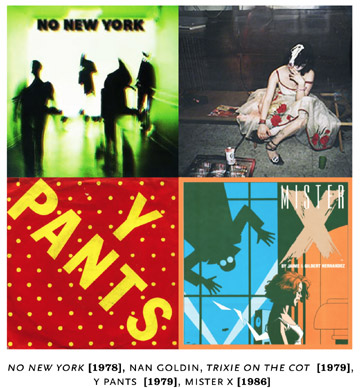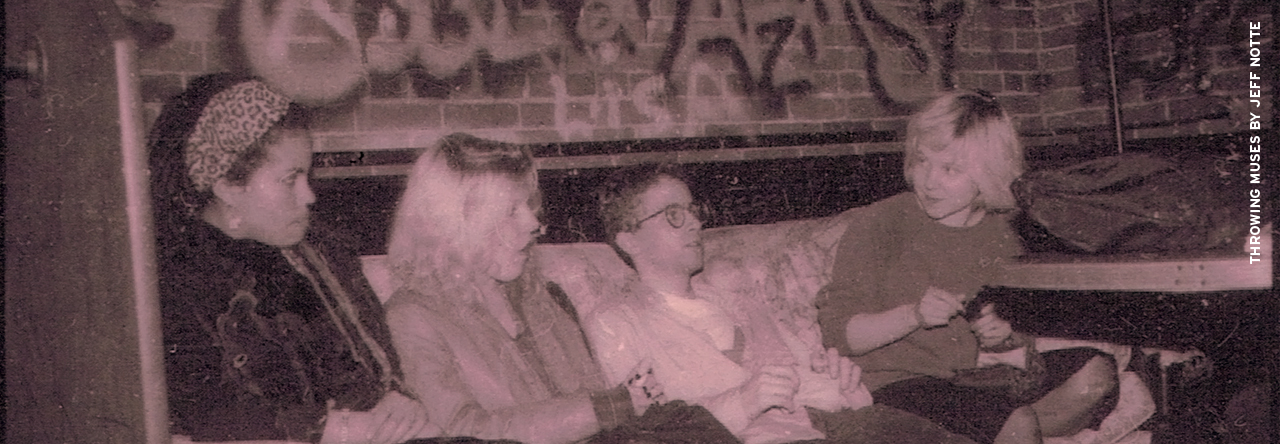 IF, AS LEGEND HAS IT, Sire impresario Seymour Stein coined the term “New Wave” to make his snappy new signings the Dead Boys more palatable to the average record-buying public, then he failed. But, since physics teaches us that every action must have an equal and opposite reaction, that alone was enough grit in the oyster to expel No Wave, the loose conglomerate of mostly New York-based bands mining a particular, rather narrow seam of very dark matter. (And wow, could I mangle that metaphor any more thoroughly? Thanks. I’ll be here all week.)
IF, AS LEGEND HAS IT, Sire impresario Seymour Stein coined the term “New Wave” to make his snappy new signings the Dead Boys more palatable to the average record-buying public, then he failed. But, since physics teaches us that every action must have an equal and opposite reaction, that alone was enough grit in the oyster to expel No Wave, the loose conglomerate of mostly New York-based bands mining a particular, rather narrow seam of very dark matter. (And wow, could I mangle that metaphor any more thoroughly? Thanks. I’ll be here all week.)
If New Wave was the well-adjusted, bubblegum version of Punk, all scrubbed clean and Technicolor-bright, then splinter offshoot No Wave better reflected the city that spawned it —ugly, depressed, crime-ridden New York City. The NYC of the late 70s was still a war zone, and bands like Teenage Jesus and the Jerks, Mars, Theoretical Girls and DNA created music that reflected that, often sounding like the city’s undiluted Id —a maelstrom of pure emotional reaction, backed by music that was twitchy and raw and often so unflinchingly emotionally intimate as to be unlistenable. Think primal scream therapy for the drone-rock set. (See Exhibit A: anything by Teenage Jesus and the Jerks, led by a young but no less confrontational Lydia Lunch and backed on sax skronk by the incomparable James Chance.)
Weirdly enough, despite the fact that I’ve seen just about every visual document of No Wave that I could lay my hands on (my favorite being Arto Lindsay’s cameo in Desperately Seeking Susan), the term itself conjures up an image of Mister X, Dean Motter and Paul Rivoche’s anti-hero of the comic-book of the same name. The eponymous hero of the title —a tall, gaunt man, bald and dressed imposingly in black shades and a sharp-shouldered overcoat, cutting an unnverving figure less Sam Spade than a superannuated philosophy student. But Mister X —despite his seeming naivete and ill-at-ease nature, is a man with a mission, spurred on by a broken heart and a secret agenda. The engine of the plot is Mister X’s impossible dream of rehabilitating his flawed, broken Radiant City (itself an echo of Corbusier’s never-built City of Tomorrow); Radiant City is the titular hero’s great love, his obsession, and his White Whale.
No Wave might not have been similarly singularly obsessed (it was too fractured as a “movement”), but, like Motter’s hero, it too teetered constantly on the brink of existential crisis. Or, indeed, of a complete breakdown. No Wave took punk’s gleeful nihilism and drained it of the glee. The anxiety of living in The City was magnified and amplified through cheap speakers. Certainly, no musical movement, not even CBGB’s-era first-wave Punk, captured the push-and-pull of love/hate —the purity of ambivalence— about modern city living like No Wave did. While not typically descriptive in any prosaic sort-of way, the City as an entity, as a Concept, looms large in every song. Maybe too large —No Wave burned itself out all too quickly, lasting fewer than five years as a movement (not that it ever was one in any conventional sense —the term was merely tacked on to bands by critics long after-the-fact).
If you’re interested in the music, the seminal document of No Wave, Brian Eno’s No New York has just been reissued by Russian label Lilith. While the liner notes are sadly in Cyrillic, the lyric sheet is in English. At last you can understand what Lydia’s been caterwauling about all these years (something about cement glowing gray and puking elastic, apparently). The offerings from James Chance are the (comparatively) lightest songs on offer, if only because their extreme nihilism is tempered by Chance’s innate sense of showmanship and bright sax flourishes. They’re still not the easiest listening you’ll find (certainly not compared to what many consider to be his finest hour, “Contort Yourself”).
DNA’s songs are perhaps the most fascinating discovery on this reissue. Arto Lindsay’s throaty shriek would be completely goofy if not for the deadly seriousness of the lyrics: “I can compete with life and all its details/Don’t hold my hand/Don’t hold me in your hand/ Throb like a bloody bone eye.” The music is angular, spare, running hot and old all at once —throwing off shards and sparks like some unholy (recombinant?) mutation of the Plastic Ono Band and Captain Beefheart. I listened to “Egomaniac’s Kiss” in the freezing cold while waiting for the bus the other morning and it stunned me so thoroughly that I almost missed the damn bus. DNA are that diverting. (And more listenable than you might think, given their reputation for eardrum-shredding noise.) Although Lindsay’s subsequent projects have toned down the noise-rock experimentalism in favor of more a more lilting, lyrical approach (one more overtly influenced by the folk musics of his native Brazil), the molten core of his unnerving, idiosyncratic songwriting style is all there in songs like “Blonde Redhead” and “Lying on the Sofa of Life.” (Fun DNA fact: Mireille Cervenka, Exene’s late sister, was in the first iteration of the band.)
One of the most unsung bands to emerge from No Wave is Y Pants. The only No Wavers to dare incorporate ukelele and toy piano into their instrumental repetoire (talk about a unique take on the power trio), Barbara Ess (The Static), Gail Vachon and Virginia Persol created some of the most charming, shambolic, and slyly feminist songs of the era (think of them as New York’s answer to the Raincoats). Their cover of Lesley Gore’s’ “That’s the Way Boys Are” is a chilling, canny masterpiece in upending a song’s text and subtext (not to mention wryly subverting the usual rock clichés about puppydog love); “Favorite Sweater”, by contrast, is one of the few No Wave songs that will make you grin from ear to ear. The band’s complete discography has been reissued by Periodic Document and should be readily available.
Oh, and pay no attention to Vice’s Yes New York CD from last year. Vice says “tribute”, I say “weak link.” Not that Yes New York doesn’t have some worthy bands —Calla and the Rogers Sisters among them— but be wary of any comp centered around the Strokes, YYYs and their ilk. Or, indeed, of anything from Vice.*
*Okay, okay, we’ll make an exception for Bloc Party.


Andrea
I do wish someone, somewhere, would reprint the entire run. I guess that would be impossible given the fact that the publisher never paid anyone and there’d undoubtedly be legal action.
There was a collection of the first four issues (the Hernandez Bros. ones). I’m sure you could find it on ebay. I have a hardcover edition in French!
Jesse
I enjoyed reading this. Thanks!